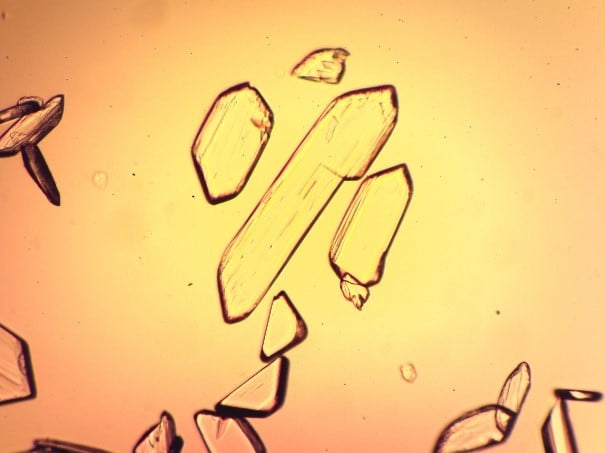Wine Tartrate Stability
 ">
">
The presence of tartrate crystals in bottled wine is commonly perceived as a fault by consumers. These crystals are mostly composed of potassium bitartrate, and the formation of potassium salts can be prevented with the use of protective colloids.
POTASSIUM BITARTRATE
Testing Wine Potassium Tartrate Stability
The Minicontact test (measurement of wine conductivity variation before and after refrigeration for 30 minutes with potassium bitartrate seeding) and the cold test (6 days storage at -4°C) are reliable tests for evaluating wine stability.
Wineries that do not have access to the Minicontact test and want to save time, often prefer to use the freeze/thaw test (wine is frozen for a few hours and then thawed before being inspected for any sign of crystalline tartrate precipitation). This method overestimates wine instability. As ice formation occurs, all solutes, including potassium, tartaric acid and alcohol, are concentrated and the precipitation that happens is not related to wine concentration condition. Furthermore, ice formation damages protective colloid structure that consequently lose their stabilizing effect. For this reason, its use is not recommended.
Potassium Bitartrate Stabilization
There are various methods that can be used in winemaking to reduce potassium bitartrate (KHT) precipitation in bottled wines. Some techniques are considered “subtractive” and involve reducing the concentration of tartaric acid and/or potassium in wine (tank cooling, electrodialysis, cation exchange resins). Other “additive” techniques make use of protective colloids or crystallization inhibitors which can be added to wine. Additive techniques are more respectful of sensory qualities and environmentally friendly. However, not all permitted protective colloids are equally effective and some of them have specific limits under certain circumstances (Table 1).

Protective Colloid Stabilizing Mechanism
Despite the differences among protective colloids, the stabilizing effect depends on their capability of resisting the growth of the nuclei around which crystals are formed. If the dose is too low, inhibition is only partial, and anomalies and unevenness are observed in the shape of the crystals (Picture 1).

Wine Suitability for Stabilization with Colloids
When protective colloids are used for KHT stabilization, wine must first meet some requirements:
1) Protein Stability
CMC and potassium polyaspartate (KPA), unlike mannoproteins, are quite reactive with wine proteins due to their high negative charge. For this reason, it is imperative to check wine protein stability and be sure wine is well below the maximum stability limit, whatever the analytical method used. Wines close to the stability limit can form haze or sediment when CMC and/or KPA are added. Preliminary lab addition trials can easily be performed and are very useful for preventing problems and extra labor in the cellar. If haze appears, bentonite fining is necessary.
2) Color Stability
Color stability is a necessary requirement for all red and rosé wines, regardless of whether they are tartrate stabilized through the use of colloids.
With the exception of CMC, tartrate stabilizing colloids do not stabilize nor destabilize wine color. CMC, on the other hand, can react with color compounds causing their precipitation even in
color stable wines. This is the reason why CMC is not permitted for red wine stabilization by the EU regulation nor by the OIV. With rosé wine application, it is best used in combination with gum Arabic.
3) Filterability
Wine filterability must be adequate for final filtration.
KPA does not change wine filterability. Once homogenously distributed, wine can immediately be bottled.
However, mannoproteins and CMC can decrease wine filterability.
CMC’s effect depends in its degree of polymerization (DP): the higher the DP, the greater the clogging effect. With high DP CMC, waiting 3-4 days between addition and final microfiltration helps return the filterability index to acceptable values.
Mannoproteins can have very different average molecular weights depending on the method used for their production. Consequently, they can have a different impact on wine filterability. Information provided by suppliers is helpful to understand how to manage filtration.